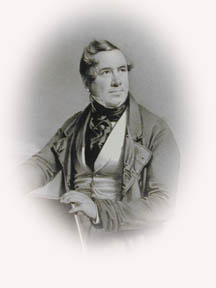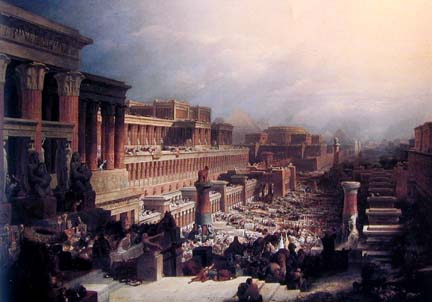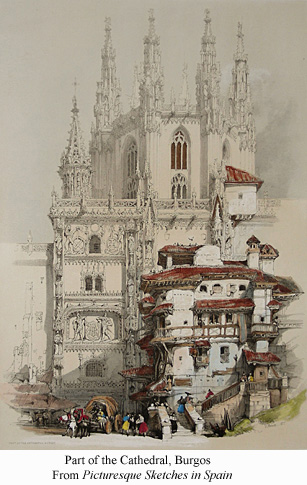
About David Roberts

About David Roberts
(All
illustrations in this Article are from Medina Arts' catalog
of David Roberts lithographs unless otherwise noted.)
David Roberts, born near Edinburgh in 1796, began his artistic career at age 11 as an apprentice to a painter of murals for the homes of the wealthy. By age 17 he had completed his apprenticeship and turned his skills to painting sets and backdrops for a circus troupe traveling through northern England. By 1819 Roberts had moved on to scene painting, first for the Edinburgh Pantheon and then for the Theatre Royal in Glasgow.
Upon relocating to London, Roberts continued his scene painting work, progressing
to the production of elaborate sets for the Covent Garden Opera. At the same
time Roberts worked to become an accepted formal landscape painter, concentrating
on architectural scenes from England, Scotland and France. As his reputation
gradually increased, he acquired a number of wealthy patrons, including Lord
Northwick for whom Roberts completed a monumental painting of the Departure
of the Israelites in 1829. This
large canvas established Roberts' reputation, though more as a painter of dramatic
architecture than of landscapes or Biblical scenes. 
Initially, like most painters of the day, Roberts did not travel outside of England and Scotland, and for scenes of foreign locations artists typically relied on descriptions and sketches brought back by returning travelers, which were often misleading, inaccurate or incomplete. Hence the scene Roberts imagined in the Departure of the Israelites, though grand and visually compelling, bore little resemblance to the reality of Egyptian architecture, save in some of the decorative details.
But Roberts was a traveler at heart,
and correctly concluded that it would be far more accurate to compose architectural
and landscape scenes "on the spot". In 1830 he began traveling to
Europe to produce more accurate renderings in his drawings and paintings. His
first great success using this method was a series of paintings of Spanish scenes,
which became the basis for a book of large-scale lithographs, published in 1837
as Picturesque Sketches in Spain. (Click here
to view these lithographs offered in Medina Arts' Catalog.) Based on the success
of this work, Roberts began to lay the plans for a trip to Egypt and the Holy
Land to draw the famous ruins and biblical locations to be found there. He believed,
rightly as it turned out, that there would be a great market in England and
Europe for images of such exotic subjects.
Throughout the summer
of 1838 Roberts arranged for his travels, withdrawing his savings to pay for
necessary expenses. He was not then a wealthy man, and the entire project was
very much a gamble. At the end of August Roberts departed for Alexandria, at
the mouth of the Nile River, arriving after nearly a month at sea. Armed with
letters of introduction to British diplomats and Egyptian officials, Roberts
made his way to Cairo, where he hired a small boat and crew to carry him up
the Nile. He was now ready to begin his work in earnest.
![]()
![]()